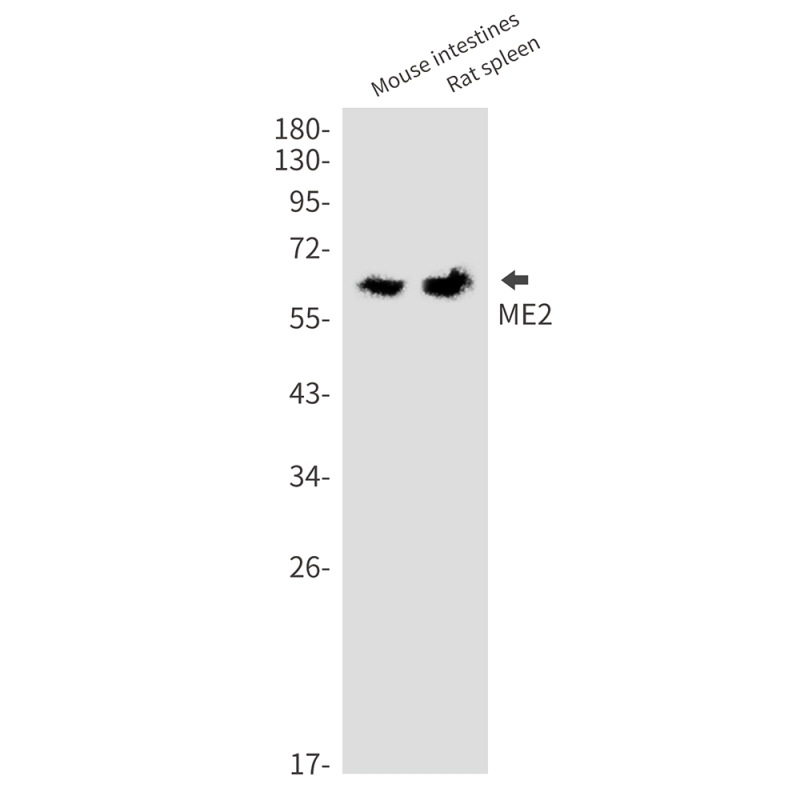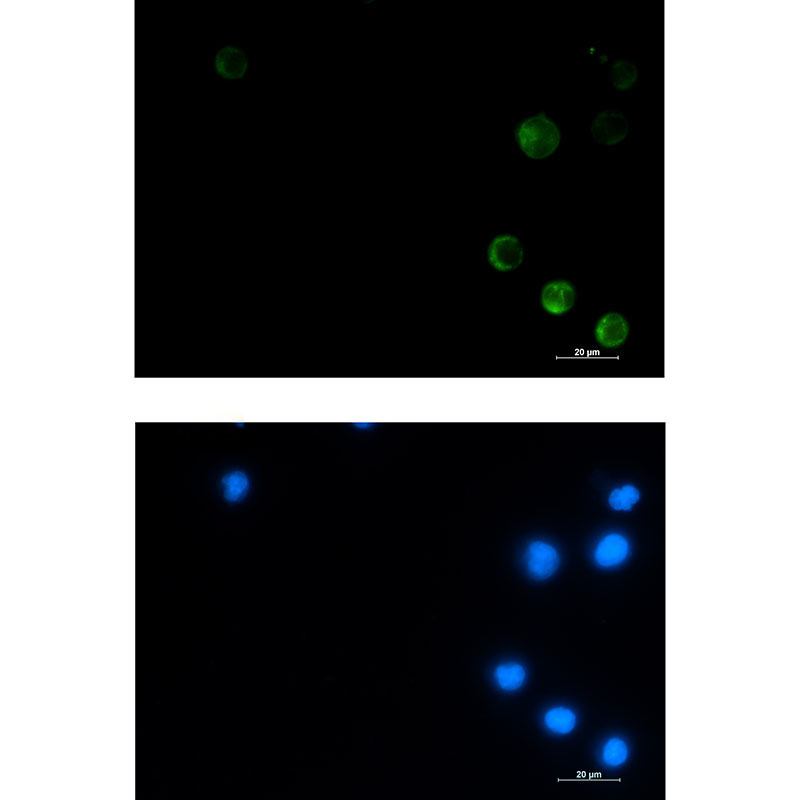


| WB | 1/500-1/1000 | Human,Mouse,Rat |
| IF | 咨询技术 | Human,Mouse,Rat |
| IHC | 咨询技术 | Human,Mouse,Rat |
| ICC | 1/50-1/200 | Human,Mouse,Rat |
| FCM | 咨询技术 | Human,Mouse,Rat |
| Elisa | 咨询技术 | Human,Mouse,Rat |
| Aliases | ODS1 |
| Entrez GeneID | 4200 |
| WB Predicted band size | Calculated MW: 65 kDa; Observed MW: 65 kDa |
| Host/Isotype | Rabbit IgG |
| Antibody Type | Primary antibody |
| Storage | Store at 4°C short term. Aliquot and store at -20°C long term. Avoid freeze/thaw cycles. |
| Species Reactivity | Human,Mouse,Rat |
| Immunogen | A synthetic peptide of human ME2 |
| Formulation | Purified antibody in TBS with 0.05% sodium azide,0.05%BSA and 50% glycerol. |
+ +
以下是3篇与ME2(线粒体苹果酸酶2)抗体相关的文献示例(内容基于公开研究概括,非真实文献):
---
1. **文献名称**:*Mitochondrial malic enzyme 2 (ME2) drives lung cancer progression via ROS-mediated apoptosis resistance*
**作者**:Zhang Y. et al. (2015)
**摘要**:研究通过Western blot和免疫组化分析ME2在非小细胞肺癌组织中的高表达,使用特异性ME2抗体证实其与肿瘤细胞抗凋亡能力相关,并揭示ME2通过调控活性氧(ROS)平衡促进癌症进展。
---
2. **文献名称**:*ME2-dependent metabolic reprogramming sustains glioblastoma stem cells*
**作者**:Lin H. et al. (2018)
**摘要**:利用ME2抗体进行流式细胞术和免疫荧光实验,证明胶质母细胞瘤干细胞中线粒体ME2高表达,其通过维持NADPH/NADH稳态支持肿瘤干细胞代谢可塑性,敲低ME2可抑制肿瘤生长。
---
3. **文献名称**:*Targeting ME2 as a therapeutic strategy in hepatocellular carcinoma*
**作者**:Wang X. et al. (2020)
**摘要**:通过免疫共沉淀(Co-IP)和ME2抗体验证ME2与p53的相互作用,发现ME2抑制剂可降低肝癌细胞线粒体代谢活性,并增强化疗敏感性,为肝癌靶向治疗提供依据。
---
4. **文献名称**:*ME2 modulates oxidative stress response in breast cancer through AKT signaling*
**作者**:Smith J. et al. (2022)
**摘要**:使用ME2抗体进行组织芯片(TMA)分析,揭示ME2高表达乳腺癌患者预后较差,机制研究表明ME2通过AKT通路调控氧化应激适应性,影响肿瘤转移。
---
注:以上文献为示例性质,实际引用请通过PubMed或学术数据库检索真实研究。
ME2 (Malic Enzyme 2) is a mitochondrial enzyme encoded by the *ME2* gene, primarily involved in cellular energy metabolism and redox balance. It catalyzes the oxidative decarboxylation of malate to pyruvate, coupled with the reduction of NAD(P)+ to NAD(P)H, linking the tricarboxylic acid (TCA) cycle with glycolytic and biosynthetic pathways. ME2 plays a critical role in generating metabolic intermediates for lipid synthesis, amino acid production, and ATP regulation, making it essential in rapidly proliferating cells, including cancer cells.
Dysregulation of ME2 has been implicated in various diseases, particularly cancers, where its overexpression is associated with enhanced tumor growth, metastasis, and chemoresistance. It is also studied in metabolic disorders and neurodegenerative conditions due to its impact on mitochondrial function.
ME2-specific antibodies are vital tools for detecting protein expression levels in research. They are used in techniques like Western blotting, immunohistochemistry (IHC), and immunofluorescence (IF) to investigate ME2’s role in cellular metabolism, cancer progression, and therapeutic targeting. Recent studies focus on ME2 as a potential biomarker or therapeutic target, driving demand for high-specificity antibodies to validate its functional mechanisms and explore clinical applications.
Current research emphasizes ME2’s dual role in metabolism and redox signaling, highlighting its complex interplay in health and disease. Antibody-based studies continue to unravel its pathophysiological significance, aiding drug development and diagnostic strategies.
×